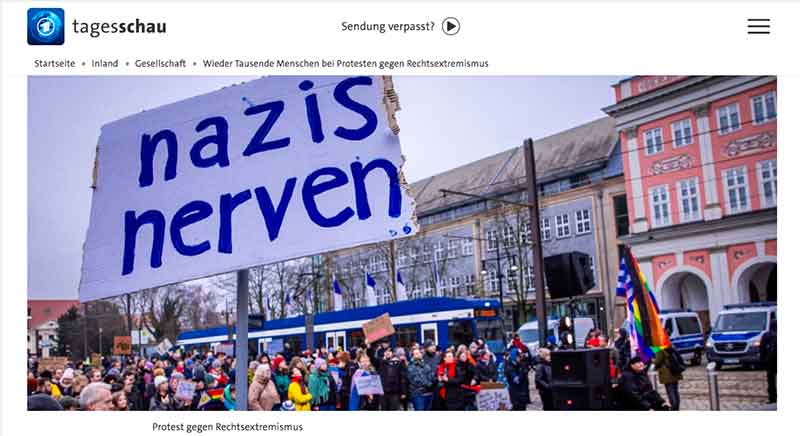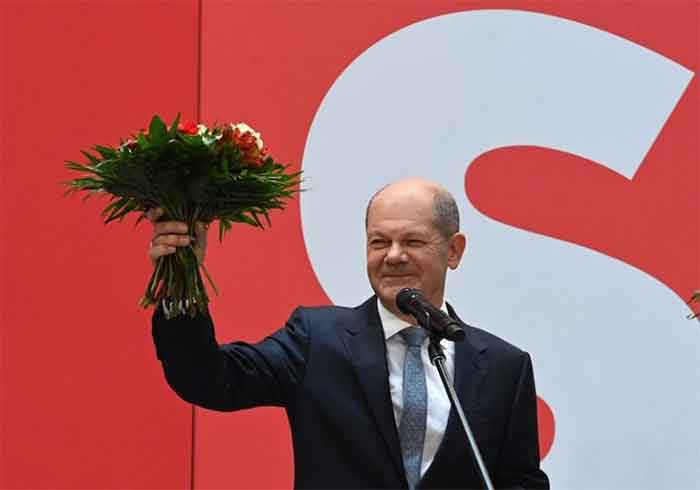by Thomas Klikauer & Meg Young

In Germany’s 2021 federal election (26th September 2021), Germany’s Neo-Nazi – some say right-wing populist – party, the AfD stabilized its 2017 result losing slightly. Still, about five million Germans voted for the AfD in 2021. The AfD remains part of Germany’s Radical Right Populism in Germany. The party – the Alternative für Deutschland operates within the history and politics of Germany’s right-wing populism and almost all of the AfD’s precursors have a strong Neo-Nazi history.
Not surprisingly, the ideology of the AfD is staunchly Volkischer nationalism based on race and Aryan whiteness. Yet, the AfD still has an anti-EU stance even though it receives diminished importance.
For the AfD, the much more important issues are xenophobia and racism predominantly set against Islam, as well as anyone not too German-looking. Of course, this extends to anti-Semitlism. Relative side issues are the AfD’s anti-gender ideology and its neoliberal ideology.
While the AfD may indeed be seen as a Neo-Nazi party, many see the AfD simply as a party of right-wing populism. Right-wing populism or authoritarian populism can be seen as a thin-centred ideology because the ideology and the concept of populism contributes not much to the understanding of the AfD.
Yet, core to authoritarian populism is the idea to separate society into two homogeneous and antagonistic camps. This sets the so-called “pure people” against some elusive, but always “corrupt elite”.
This makes it perfect for German right-wing extremism because it still imagines the coming of the Aryan Volksgemeinschaft. In such a Volksgemeinschaft, for example, what Rousseau once called volonté générale (general will) of the people – is not found through Rousseau’s democracy. Instead, it is expressed through the will of the leader – the Führer.
In authoritarian populism, it can indeed be argued that there is a distinction between vertical and horizontal populism. In this, the vertical dichotomy is implied as a fight between the people and the elite while at the horizontal level, there is the fight between inside and outside – between Muslims and Aryans. Set against this is an even more important distinction which takes place at the vertical/horizontal level. Here, it is not just “in-group” versus the “out-group”.
Instead, the horizontal level is designed to, at least ideologically, eliminate the more important top-down and vertical opposition between labor and capital. Moving from the important top-down to the ideologically-motivated horizontal (group against group), it further diminishes the class and capitalism from the minds of the people. The focus on setting people against people to eliminate class and capitalism is nothing new for authoritarian populism.
On the AfD’s ideological precursors, one might note the former Waffen-SS member Schönhuber and his “The Republican” party. Yet, there are also various so-called “pro-initiatives” like the xenophobic and racist “Pro Cologne” initiative. But there is also the right-wing extremist “Schill Party” hooked on law and order.
Yet, not to be forgotten, there still looms the ghosts of Hitler’s Nazi party, the NSDAP. And there is the follow-up Neo-Nazi party, the Socialist-Reichs-Party (SRP) which was declared illegal during the 1950s. Beyond that, the more importantly, the immediate predecessor of the AfD, remains Germany’s most long-lasting Neo-Nazi party, the NPD.
As a consequence, the history of the AfD cannot start with the 6th of February 2013 – the date of birth of the AfD. Instead, the history of the AfD started long before that. In reality, the history of the AfD starts with the history of post-war Germany when plenty of ex-Nazis were made to flourish during Germany’s post-Nazi years often finding an ideological home in the SRP first, and in the NPD later. Today, most of them have moved to the AfD.
AfD members and supporters did not magically appear in 2013. Like the real Nazis of the 1930s and 1940s, Germany’s real Nazis did not suddenly drop from the planet Mars in 1933 and then mysteriously returning to Mars in 1945, as the common ideology of an “hour zero” insinuates.
Ideologically asphyxiated in the late 1930s, today’s many AfD members joined a racist and chauvinistic party with a strong distaste for non-Aryans. Soon after the AfD’s founding act, immigration became the main ideological issue on the agenda of the AfD. This led to a stunning electoral victory when the AfD received 12.6% of voter support during the federal election of 24th September 2017.
For those hoping that the AfD would be short-lived, the results of the 2021 election proved otherwise. According to German officials, the AfD received 10.3% of voter support in 2021, down 2%. In other words and despite the non-existence of the much trumped-up refugee chaos during recent years, the AfD has a stable support of 10% with a 19% (east) and an 8% (west) split. In short, the AfD is 2.4 times stronger in the former East-Germany compared to the western parts of Germany.
In the 2021 election, the AfD lost 7.2% of its voters to the social-democratic SPD; 8.4% to Merkel’s conservative CDU; virtually none to the environmentalist Greens (1.4%); even less to Germany’s socialist party The Linke (1.2%), but a whopping 13.8% to a newly formed anti-vaxx party.
In terms of political issues, AfD voters still see the AfD as the party of protecting their Aryaness from foreigners. 40% said, they voted for the AfD because of that. Roughly 20% said the AfD anti-vaxx ideology made them voting for the AfD while a further 20% said law and order. A whopping 97% believe the AfD makes them feel safe while 95% said the AfD protects them from foreigners.
The most obvious difference in voting for the AfD lies between West-Germany and former East-Germany. In the former East-Germany, the social-democratic city of Berlin remains an exception. The AfD “only” received 8.4% in Berlin which is well below its Germany-wider average. In neighboring Brandenburg, the AfD received 18%, in the northern state of Mecklenburg-Vorpommern (Merkel’s home state), the AfD also got 18%.
In Lower Saxony, it got 19%. The AfD’s strongholds are far eastern state of Saxony where it has become the strongest party with almost 25% closely followed by neighboring Thuringia’s 24%. In the 1,500 strong far eastern Saxon town of Dorfchemnitz with a meagre 3.5% of non-Germans, a whopping 53% have voted AfD.
This remote town on the eastern border to the Czech Republic represents the remote area of what Germans call “Dunkeldeutschland” – dark Germany. Of course, the AfD does better in remote and rural areas compared to cities. Germany mirrors what Donald Trump once said, I love the poorly educated.
Ideologically, the AfD continues to represent a combination of volkish nationalism and ethnopluralism. The fancy-looking term “ethnopluralism” is no more than an upmarket word for Volksgemeinschaft: “ethno” means race while pluralism means they, the others, the non-Aryans. They should live over there and we (the Aryan Germans) should live here.
In this ideology, pluralism stands for two racially segregated areas: a German and a non-German – a modern version of Lebensraum. Of course, if this is to be achieved through authoritarian – it means following the AfD’s authoritarianism, as well as the AfD’s volkish nationalism as this remains the party’s core ideology. This is spiced up through the AfD’s hostility towards Islam.
Yet, racism and anti-Islamism has an additional advantage for the AfD. The Islamophobia of the party can also be attested by the strong bond between AfD and the anti-Islam movement Pegida. The leader of Pegida is Lutz Bachmann. Some might mistakenly see Lutz Bachmann as a colourful personality, who thinks it is funny to pose as Adolf Hitler on his Facebook page.
Yet, the Pegida-boss Bachmann is actually a failed career criminal who enjoys violence and brutality. Meanwhile, Bachmann’s Adolf Hitler dressing-up should not be belittled as being “funny”. The man is a serious Neo-Nazi.
That Bachmann is a man – signifies the AfD. Strong manhood and the showing off of masculinity are not uncommon in Germany’s right-wing extremism and the AfD. Men run the show inside Germany’s right-wing extremists and right-wing populist parties. This is despite the fact that the AfD likes to present a pretty Lesbian residing in Switzerland as the public face of the AfD.
The AfD is indeed one of Germany’s radical right’s Männerparteien – men’s parties – mostly old men. Indeed, the AfD is a party by men for men. Not surprisingly, this is not in contradiction to the AfD’s homophobia – rather the opposite. Beyond that, the AfD is also a neoliberal party.
Rather problematic are claims that AfD did very well during the 2017 election among unionized workers with 15% of workers voting for the AfD. This also means that 85% of union-members did not vote for the AfD. Still, 15% was higher than the AfD’s 12.6% achieved in Germany’s federal election of 2017. Yet, like the NSADP, the AfD too, is not a party for the working class.
Being no working class party but pretending to represent the little people, the AfD has entered all of Germany’s seventeen parliaments. Today, it sits in all sixteen state parliaments and Germany’s federal parliament. Plenty of studies have shown that the AfD portrays two distinct features when it comes to their parliamentarian work:
a) unpreparedness, lack of knowledge, and no understanding of the subjects at hand; and
b) mob-behaviours, disruptions, personal attacks on others, insults, and utter destructiveness.
Inside German parliaments, the AfD staunchly follows Nazi-lawyer Carl Schmitt’s distinction between a friend and an enemy. This implies that the enemy has to be destroyed. Perhaps in addition to that, the AfD also adheres to Reichs-Propaganda-Minister Joseph Goebbels’ dictum of:
this will always remain one of the best jokes of democracy,
that it gave its deadly enemies the means by which it was destroyed.
Inside Germany’s democratic institutions, the AfD works tirelessly to exploit those and to undermine those. Even in parliaments, the AfD pushes its volkish nationalism. This remains its core ideology just as it does for the radical right populists in Germany as a whole. In parliament, the AfD continues to show its highly obstructive and extremely destructive parliamentarian behaviour.
Being in parliament also allows the AfD to cash-in of state support. Beyond that, the AfD has also shovelled Neo-Nazis into the ranks of its parliamentarian support staff. With its political status confirmed by receiving 10.3% in the 2021 election, the AfD will continue to exploit what the democratic state has to offer until it can destroy it.
Thomas Klikauer is the author of “the AfD” (Sussex Academic Press, 2020).
Meg Young is a Sydney Accountant who likes foreign movies and enjoys proof reading.
Originally published in BuzzFlash

















































